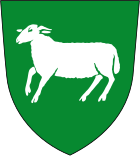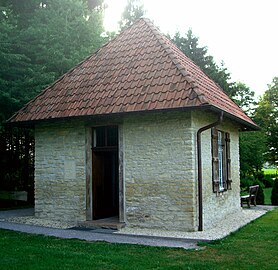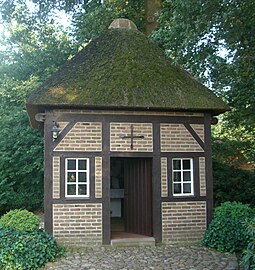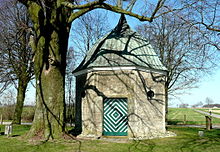Schoeppingen
| coat of arms | Germany map | |
|---|---|---|

|
Coordinates: 52 ° 6 ' N , 7 ° 14' E |
|
| Basic data | ||
| State : | North Rhine-Westphalia | |
| Administrative region : | Muenster | |
| Circle : | Bark | |
| Height : | 90 m above sea level NHN | |
| Area : | 68.81 km 2 | |
| Residents: | 6868 (Dec. 31, 2019) | |
| Population density : | 100 inhabitants per km 2 | |
| Postal code : | 48624 | |
| Primaries : | 02555, 02545, 02558 | |
| License plate : | BOR, AH, BOH | |
| Community key : | 05 5 54 052 | |
| LOCODE : | DE XSP | |
| Community structure: | 3 districts (Schöppingen, Eggerode, Gemen ) | |
| Address of the municipal administration: |
Amtsstrasse 17 48624 Schöppingen |
|
| Website : | ||
| Mayor : | Franz-Josef Franzbach (independent) | |
| Location of the community of Schöppingen in the district of Borken | ||
Schöppingen ( Low German Schüöping ) is a municipality in the western Münsterland in the northwest of the state of North Rhine-Westphalia and is a municipality in the district of Borken in the administrative district of Münster .
The area of the municipality of Schöppingen is 68 km², which is quite large in relation to the number of inhabitants. With an average age of 34.7 years, Schöppingen is the “youngest” municipality in the Borken district.
geography

The municipality of Schöppingen is located in the north of the Borken district. Close by, on the outskirts of the neighboring community of Horstmar , at the so-called "Dreiländereck", the three districts of Borken, Coesfeld and Steinfurt meet.
The place is located on the Vechte , a 167 km long river, which arises in the district Eggerode from the confluence of the brooks Burloer Bach and Rokeler Bach and flows first to the north towards the Nordhorn , then to the west.
To the east, Schöppingen is bounded by the Schöppinger Berg , a foothill of the Baumberge and at 157.6 m above sea level. NN the highest point in the Borken district.
History and economy
An indication of the centuries-old culture and agricultural activities are the numerous Eschfluren, especially east of the Vechte and on the northern edge of the Osterwick hill country. The agriculturally used area is 79.1% of the total cadastral area and thus illustrates the landscape-defining character of agriculture in the Schöppingen area.
While the first agriculturally used areas, which resulted from clearing, were largely only used for self-sufficiency, in the Middle Ages, with the development of larger settlements and fortified cities, the goods produced in agriculture were also merchandise. The expansion of production also required a larger space requirement - the clearing was expanded. An initial expansion phase was the establishment of the Eschfluren, along with the establishment of the Schultenhöfe along the Vechte as well as Üding, Höping, Haverbeck and Gemen . The former woodland experienced a further clearing through the use of the common land or the common use of the branded land . Due to forest pasture and overgrazing, the forest areas were pushed back further. The medieval landscape experienced a renewed expansion of the production area due to the Kötter, who settled on the edge of the existing corridor . In the farming community of Heven, these cottages were at the very edge of the Wersche. Until the beginning of industrialization in the 19th century, agriculture was the main livelihood of the rural population.
Even today, agriculture still determines the landscape, but there are only a few people who are employed in agriculture. In 1999 only 3.1% of all employees subject to social security contributions in Schöppingen were in the “Agriculture, forestry, fishing” division. The ratio of part-time employees (307) and full-time employees (129) in Schöppinger agriculture for 1999 illustrates the low and continuing decline in employment opportunities in modern agriculture.
Structural change began in agriculture as early as the 1950s through rationalization and intensification. Schöppingen thus became a focus of the agricultural processing industry in North Rhine-Westphalia. Of 213 farms counted in 1999, 56.3% devoted themselves exclusively to processing and 19.7% to fodder cultivation. In 1999, Schöppingen had the highest pig density in the Borken district, with 1380 pigs per 100 hectares of agricultural land. The absolute numbers also reflect this. After the city of Borken (102,223 pigs) and the city of Ahaus (85,025 pigs), the farmers of the municipality of Schöppingen held the third largest pig population in the district of Borken in 1999 with 73,637 (district of Borken 2001). The Tummel company in Schöppingen is one of the largest pig slaughterhouses in Germany. With 219,897 chickens, Schöppingen also took a leading position in poultry production in the Borken district in 1999.
The structural change in agriculture over the past twenty years has already shaped the landscape. The proportion of grassland in the agricultural area in Schöppingen shrank from 40% (approx. 2172 ha) in 1977 to 9% (490 ha) in 1999. At the same time, the proportion of arable land in the agriculturally used area increased from almost 60% (1977) to 90% (1999).
As in previous years, the budget was balanced in 2008. In 2008, however, around € 1,000,000 in allowances in the country were lost as tax revenues increased. As a result, around € 220,000 more social security contributions etc. had to be paid, which resulted in a minus of € 1,500,000 in 2009, which, however, could be compensated for by the reserves of recent years. Last year, Schöppingen's debt was reduced by € 1,300,000 to € 1,670,000. At 2.68%, the share of social assistance recipients is the lowest in the Borken district (compared to Gronau:> 8%).
Community structure
On July 1, 1969, the communities of Wigbold Schöppingen , Kirchspiel Schöppingen and Eggerode were merged to form the new community Schöppingen.
Development of the postal system in Schöppingen, Heven and Eggerode
Politics and administration
Municipal council
The elections to the municipal council in 2004, 2009 and 2014 produced the following results:
| Election year | CDU | UWG | Green | SPD | FDP | voter turnout | |
|---|---|---|---|---|---|---|---|
| 2014 | Result | 51.8% | 29.9% | 7.0% | 9.7% | 1.6% | 59.0% |
| 2014 | Seats | 14th | 8th | 2 | 2 | - | |
| 2009 | Result | 50.4% | 28.1% | 6.3% | 7.7% | 7.6% | 64.6% |
| 2009 | Seats | 14th | 7th | 1 | 2 | 2 | |
| 2004 | Result | 49.8% | 38.9% | 6.2% | 5.1% | - | 68.7% |
| 2004 | Seats | 13 | 10 | 2 | 1 | - |
The CDU was able to obtain its absolute majority in 2014, the FDP is no longer represented in the local council.
mayor
In the municipal elections in North Rhine-Westphalia in 2009, the incumbent non-party mayor Josef Niehoff was re-elected with a vote of 77.3% against an opposing candidate. He was replaced in the mayoral election on September 13, 2015 by Franz-Josef Franzbach (CDU / voter group), who won the election with 87.7% of the valid votes ahead of Jürgen Holste (SPD).
Community partnerships
Schöppingen maintains a community partnership with Diepenheim in the Netherlands .
Culture and sights
Sights are the old town hall built in 1583 . and the pilgrimage site of St. Mary's Birth, Eggerode. The listed Antonius Church is also remarkable .
The Künstlerdorf Schöppingen Foundation is an international scholarship institution for artists, authors and composers. The scholarships are advertised worldwide every year. The selection is made by expert juries.
- Kulturring Schöppingen e. V.
- Freundeskreis Schöppinger Concerts e. V.
The church concerts in the St. Brictius Church and the concerts in the Old Town Hall have been part of Schöppingen's cultural program for many years. The parish of St. Brictius and the current forum, adult education center organize this series and enjoy the support of the community of Schöppingen, the Sparkasse Westmünsterland, the Volksbank Gronau-Ahaus and various private donors and sponsors.
Concerts have been held over the years that have become known far beyond Schöppingen's borders because of their high artistic quality. Highlights were B. the performance of the Tölzer Knabenchor in June 2005, the concert reading with Ernesto Cardenal in March 2006 or the piano evenings with Claudius and Adrian Tanski.
The Freundeskreis has set itself the task of regularly informing the friends of classical concerts about current concerts and helps to finance these concerts and to keep the admission prices moderate. The registered association was constituted in October 2005 and already has around 30 members.
Chapels on the Chapel Route
- Stockum Chapel (1707),
- Chapel of the house Koppel (1707),
- Chapel of the Schulze Althoff court (1707),
- Chapel of Grace in Eggerode (1843/1844),
- Pest chapel in Gemen (approx. 1650)
- Attractions
Mountain chapel on the Schöppinger Berg
The mountain chapel was built after 1707, in some cases the year 1718 is also specifically mentioned. It had a previous wooden building that had already served as a processional station. The initiative to build the new chapel came from the Schöppingen pastor Jacob Anton Volbier. He was the owner of a vicarie from 1709 and pastor in Schöppingen from 1716. As early as the year after its introduction, he began planning the mountain chapel, which was presumably inaugurated in 1718 on the occasion of the corridor procession. It was financed by donations, two large collections and the church treasury. Unlike many other chapels, it was not privately owned. Outwardly, too, it differs from these. It has an octagonal floor plan. The quarry stone masonry is crowned by a bell-shaped roof. Inside is an altar donated by Albert Everding in 1720. In baroque pseudo-architecture it shows a Madonna and Child on the crescent moon, with St. Joseph and St. Anthony of Padua, who also each carry a baby Jesus, which is represented three times. To St. Joseph and St. The chapel was consecrated to Anthony of Padua.
A stop was made here on the occasion of the “Great Procession”, with observants from Münster holding the sermon. Since 1969, the traditional "hail party" was held for the first time as a petition to the mountain, followed by a high mass at the mountain chapel. In 1962 the mountain chapel was restored for the first time and in 1980 for the second time. The members of the church choir, who continue to take care of the chapel, got involved. The Stockum Chapel, the Koppel chapel and the Schulze Althoff chapel are on the procession route. Two other chapels should also be mentioned, which are located in the municipality of Schöppingen - in the district of Eggerode and in the farming community of Gemen. They are not directly on the chapel route, but can be reached quickly with a short detour and are definitely worth a visit.
Parish Church of St. Brictius
The Schöppinger Church of St. Brictius was built on a conquered Saxon refugee castle, at the foot of which a source, the “wave”, rises, which was the place of judgment and perhaps also a place of worship. The first church was about 8 × 15 meters and probably already built of stone. When Liudger was ordained the first bishop of Münster on March 30, 805 , the Schöppingen baptistery became the parish church. It is mentioned for the first time in the imperial charter of June 7, 838, in which Emperor Ludwig the Pious donated the churches to Reni ( Rheine ), Wateringas ( Wettringen ) and Stochheim in the Gau Scopingus (Schöppingen) to the Herford monastery.
The church was rebuilt around 1100. The mighty tower from this time still stands, which was raised by a bell storey around 1230 and received its current form with two stepped gables. Around 1390, the town of Schöppingen was built outside the Carolingian fortified church with ramparts and moats, two gates and a centrally located town hall. The church was now outside the fortified place. It burned down on April 30, 1453 in the “ Münsterischen Stiftsfehde ”, except for the tower and the surrounding walls - traces of fire can still be found on the tower today. The church was rebuilt as a two-aisled, Gothic hall church, with the main altar located exactly on the site of the old main altar. In the Spanish-Dutch War (1566–1609) and the subsequent Thirty Years War (1618–1648) Schöppingen was badly damaged. The church was devastated and unusable.
At the end of the 19th century it was decided to demolish the church and replace it with a neo-Gothic church with a 75 meter high tower. Drafts are preserved in the parish archives, the money was already saved - when the First World War broke out and fortunately the plan was thwarted. During the inflationary period one had to be content with an extension, and so in 1923-26 the northern side wall of the previous Romanesque building was demolished and the northern, very wide aisle was added to the previous church to create as much space as possible. At the same time, the interior of the church was completely redesigned: the altarpiece was inserted into a new richly carved high altar that reached into the vault. The wall and vault paintings, which were soon rediscovered, were uncovered and restored.
House (castle) Stockum
The Stockum house was built around 1725 for the von Beverförde family according to plans by Gottfried Laurenz Pictorius . Due to severe structural damage, the von Oer zu Egelborg family, the heirs of the Stockum family, had the manor house demolished shortly after 1800 due to the risk of collapse.
Dialects
In addition to the official language High German, the "Münsterländer Platt" or "Schöppinger Platt" (every town / municipality has its own dialect) is also often spoken in Schöppingen.
Public facilities
- Youth home "Stop" Schöppingen
- Sassehaus "open meeting" Schöppingen
Former NATO position at Schöppinger Berg
The stationing of a NATO unit on the Schöppinger Berg in 1963 gave Schöppingen another positive change in the population curve. At times over a thousand NATO soldiers and their families lived in Schöppingen. On September 1, 1985, almost three years after the beginning of the continuous withdrawal of soldiers, Schöppingen had 6,189 inhabitants, of which 877 were Dutch and American NATO members. In 1987 the NATO unit was finally dissolved. Above all, the deduction represented an economic turning point. Vacant apartments and noticeably lower sales in the retail sector were not only caused by the community fathers. Housing associations and Caritas made it possible to sell or rent 92% of vacant apartments to interested parties from the Ruhr area within one year. It is now back in operation in the former NATO position. Radio amateurs use the area of the fire control area to test antennas and to take part in European and worldwide amateur radio competitions (contests).
Later use of the site
With the fall of the German-German border in 1989, GDR emigrants and subsequently emigrants from the former Eastern Bloc countries were accommodated in a supraregional reception center in the former barracks. The sudden but short-term increase in the population of Schöppingen in 1989 and 1990 documents this historical landmark of the Federal Republic (Fig. 1). The barracks site has been a reception facility for asylum seekers in the state of North Rhine-Westphalia since 1992. Since the asylum seekers are registered with their place of residence in Schöppingen, this explains the annual fluctuations in the number of residents. Even if the most recent population figures for 2002 indicate a decline in the population, Fig. 1 illustrates the general upward trend in population development. If you consider the percentage increase in the number of inhabitants for the period between 1975 and 2000, Schöppingen ranks 67% in the Borken district, ahead of Raesfeld with 66.7%. The average increase in the Borken district for the same period is 24.1%. This above-average increase is explained in Schöppingen by a particularly high influx of people. Responsible for this is not least the brisk expansion of residential building areas in the 80s (4 residential areas with 177 building sites) and 90s (9 residential building areas with 288 building sites or residential units) of the 20th century, but above all the included evaluation of the central reception center for asylum seekers .
It should be noted, however, that there is high volatility among the population. According to ZENSUS 2011, the population fell significantly by 1,465 people, i.e. over 17%, to 7,169.
education
- Secondary school: Schöppingen Verbundschule
- Primary School: St. Brictius Primary School
- Primary school: Marien Primary School Eggerode
- Kindergarten: Brictius Kindergarten Schöppingen
- Kindergarten: Nikolaus Kindergarten Schöppingen
- Kindergarten: Marien-Kindergarten Eggerode
- Kindergarten: Antonius Kindergarten Gemen
Sports
Soccer
In 1982 ASC Schöppingen rose to the Oberliga Westfalen , which was the third highest German division at the time, and held its own in the top group for ten years. In 1986 the team even took part in the promotion round to the 2nd Bundesliga and in 1991 played for the German amateur championship . This sporting high-altitude flight was made possible by the sponsorship of the butcher's Tummel. After the financial support failed to materialize, the ASC refrained from participating in the league in 1992.
Buildings
- Mobile radio tower Schöppinger Berg
- Telecommunication tower Schöppingen
- Wind turbines Schöppinger Berg
Personalities
- Heinrich von Ahaus (around 1371–1439), patron of the brothers and sisters of life together
- Brictius thom Norde (Brictius von Norden) (around 1490–1557), Lutheran theologian and reformer
- Bernd Krechting (* before 1500–1536), leader of the Anabaptist Empire in Münster
- Heinrich Krechting (1501–1580), radical leader of the Anabaptist movement
- Josef Kröger (1909–1979), official director of the Schöppingen office and writer Münsterland dialect
Web links
- Website of the community of Schöppingen
- Documents from the Schöppingen community archive / digital Westphalian document database (DWUD)
- Link catalog on the topic of Schöppingen at curlie.org (formerly DMOZ )
- Schöppingen in the Westphalia Culture Atlas
Individual evidence
- ↑ Population of the municipalities of North Rhine-Westphalia on December 31, 2019 - update of the population based on the census of May 9, 2011. State Office for Information and Technology North Rhine-Westphalia (IT.NRW), accessed on June 17, 2020 . ( Help on this )
- ↑ Pig: T he ten largest slaughterhouses in Germany , agrarheute.com, January 2, 2015
- ↑ Martin Bünermann: The communities of the first reorganization program in North Rhine-Westphalia . Deutscher Gemeindeverlag, Cologne 1970, p. 81 .
- ↑ Community administration Schöppingen (ed.): Schöppingen 838-1988 A history of the communities Schöppingen and Eggerode. Schöppingen (self-published by the editor) 1988
- ↑ Joseph Kröger. In: niederdeutsche-literatur.de. Retrieved February 28, 2020 .










